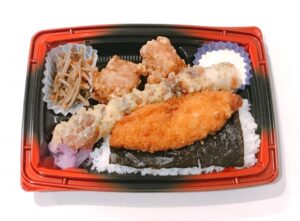History of obento

Bento is a very important part of Japanese food culture, appearing not only for everyday meals but also for special events and celebrations. Bento has long been popular as a convenient and portable meal, but its history has undergone many changes. In this article, we will unravel the history of obento, its evolution, and its role in Japanese food culture.
1 Origins of Obento

The origin of obento is said to date back to the Heian period (794 – 1185). During this period, upper class aristocrats had the custom of bringing their own meals when they went out. It is thought that early bento boxes were not box-shaped like today’s bento boxes, but instead used wrapped rice and ingredients wrapped in bamboo skins for easy consumption. Since bento in this period were mainly used as meals for ceremonies and banquets, they were often luxurious in content.
In the late Heian period, bento began to spread among the common people. Bento eaten by the common people were simple and not luxurious, but the characteristics of being easy to carry and eat are the same as today.
2 Bento Culture from the Warring States Period to the Edo Period

During the Warring States Period (1467 – 1615), “senbento” (war bento) appeared as a way to carry meals between battles. Because samurai warriors, in particular, needed to bring their own meals during expeditions, the importance of portable bento was emphasized. Bento during this period were usually made of bamboo skins or cloth wrappings stuffed with ingredients for easy portability.
In the Edo period (1603-1868), the development of the common people’s culture further diversified the bento. During the Edo period, the culture of eating out spread, and bento boxes were increasingly used for special occasions such as outings, celebrations, and festivals. It was also during this period that obento-ya (bento shops) appeared on the scene, offering readily available bento to the townspeople. Bento became an indispensable part of daily meals, especially for Edo townspeople who often ate out in their busy lifestyles.
3 The Meiji Period and the Modernization of Bento

In the Meiji Era (1868 – 1912), the contents of bento boxes began to change under the influence of Western culture. Western-style meals were introduced, and bento box lunches featuring sandwiches, ham, eggs, and other ingredients appeared. A new type of bento called ekiben was also born during this period. With the development of railroads, bento boxes were sold at stations for passengers to eat on the move, and these became popularly known as “ekiben.
During this period, bento became popular not only as something that could be homemade at home, but also as something that could be purchased outside. In particular, many families made bento for their families as a way of expressing a mother’s love and the warmth of the home. Bento boxes also evolved from wooden or lacquerware ones to plastic or metal ones, in a form that was convenient and easy to carry.
4 Postwar Bento and Cultural Change

In the postwar period, especially during the period of rapid economic growth (1950s – 1960s), Japan’s food culture underwent major changes. Bento became more and more a part of daily life, and in addition to being prepared at home, they were also available at convenience stores and vending machines. Frozen and processed foods also came into active use during this period, with more and more emphasis placed on convenience foods sold at convenience stores or as “obento” to take to the workplace.
In addition, the color and balance of the bento became a staple of lunch for office workers and students, and “noriben” and “makunouchi bento” became particularly popular. Bento is an important meal that provides a taste of home, and has become an indispensable part of lunchtime enjoyment for Japanese people.
5 Modern Bento Culture

Today’s bento comes in a variety of forms, from those prepared at home to those bought at convenience stores or train stations, and even those offered as food service. Recently, more and more bento boxes are being prepared to meet a variety of needs, including healthy and diet-conscious bento, as well as vegan and gluten-free bento. Stylish and glamorous “Insta-ei bento” bento designed to be shared on Instagram and social networking sites are also gaining popularity.
Bento culture is no longer limited to Japan, but is spreading overseas as well. More and more Japanese restaurants targeting foreign tourists are offering obento and recognizing it as a part of Japanese cuisine.
6 The Future of Obento

Bento will continue to evolve in the future. With the rise of health and environmental awareness, “eco-bento” using organic and fresh local ingredients and “food truck bento” that are easy to carry may emerge. In addition, there will be an increasing demand for bento lunches that are even shorter in time and more nutritionally balanced to meet the needs of today’s busy people.
Bento is more than just a meal. It is an important reminder of family ties, a mother’s love, and traditional Japanese food culture. As bento culture continues to evolve, it will continue to play a role in passing on Japan’s food culture to the next generation.
